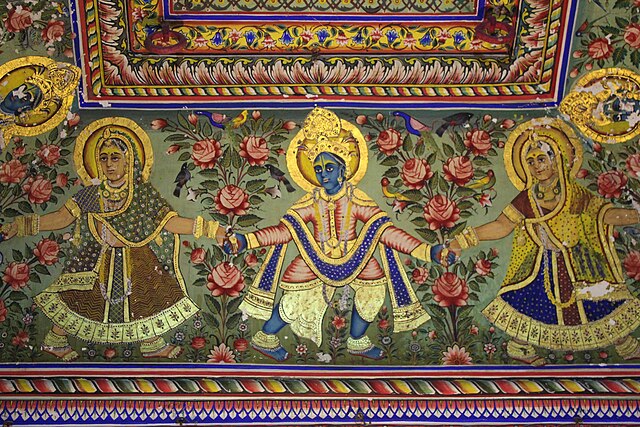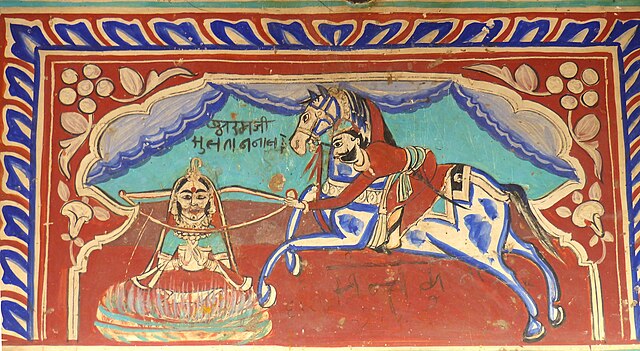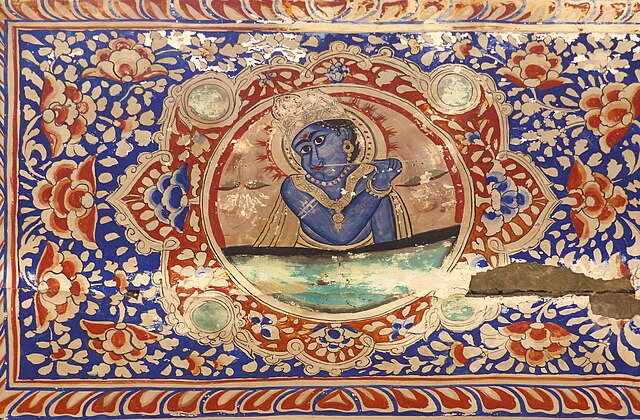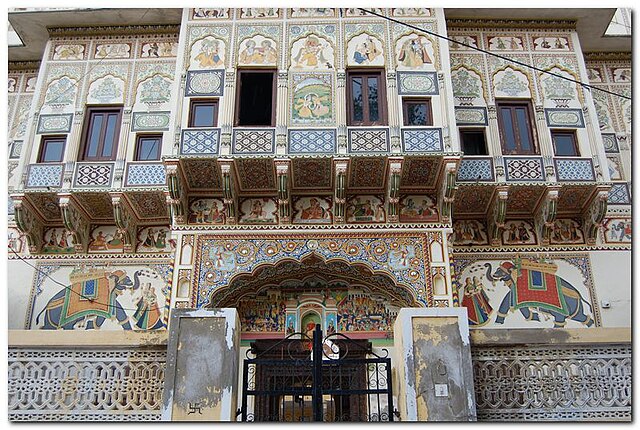Ever wondered what it’s like to step into a living canvas where every wall tells a story? Welcome to Mandawa, a small town in Rajasthan, India, that’s like a hidden treasure chest bursting with color, history, and charm. Tucked away in the heart of the Shekhawati region, Mandawa is famous for its intricately painted havelis—grand mansions that showcase the artistic brilliance of a bygone era. If you’re craving a journey that blends culture, history, and a touch of royal splendor, Mandawa is calling your name. Let’s dive into what makes this desert gem so special, shall we?
Why Mandawa Should Be on Your Travel Radar
Picture this: you’re strolling through narrow lanes lined with mansions that look like they’ve been dipped in an artist’s palette. Mandawa isn’t just another dot on the map; it’s a cultural hotspot that feels like a step back in time. Known as the “Open Art Gallery of Rajasthan,” this town is a haven for history buffs, art lovers, and curious travelers alike. From its vibrant frescoes to its warm hospitality, Mandawa offers a unique blend of heritage and heart. So, why should you visit? Because it’s not just a destination—it’s an experience that lingers long after you’ve left.
The Allure of Mandawa’s Havelis
Mandawa’s havelis are the heart and soul of the town. These grand residences, built by wealthy merchants in the 18th and 19th centuries, are architectural marvels adorned with frescoes that depict everything from mythological tales to scenes of daily life. Walking through Mandawa feels like flipping through a history book where every page is a masterpiece. The havelis, with their ornate courtyards and intricate designs, are a testament to the town’s prosperous past as a trading hub along the Silk Route.
Top Havelis to Explore
Ready to explore some of Mandawa’s most iconic havelis? Here are a few that you can’t miss:
- Chokhani Haveli: Known for its vibrant frescoes depicting religious and historical themes, this haveli is a visual feast. The artwork here is so detailed you’ll spend hours deciphering the stories painted on the walls.
- Murmuaria Haveli: This one’s a crowd-pleaser, with frescoes showcasing everything from British colonial influences to local legends. Look out for the quirky painting of a train!
- Goenka Haveli: A stunning example of Shekhawati architecture, this haveli boasts intricate mirror work and colorful murals that reflect the opulence of its former owners.
Each haveli is like a time capsule, preserving the legacy of Mandawa’s merchant families. Trust me, you’ll want your camera fully charged for this!
A Glimpse into Mandawa’s Rich History

Mandawa’s story is as colorful as its havelis. Founded in the mid-18th century by the Shekhawat Rajputs, the town quickly became a thriving trading center due to its strategic location on the Silk Route. Merchants grew wealthy, and they poured their fortunes into building lavish havelis to showcase their status. Over time, these mansions became canvases for local artists, who painted them with frescoes that blended Rajasthani culture with influences from afar. Today, Mandawa stands as a living museum, preserving the legacy of its founders and their artistic vision.
The Role of the Silk Route
Ever heard of the Silk Route? This ancient trade network wasn’t just about silk—it was a highway of ideas, cultures, and wealth. Mandawa’s merchants were key players, trading goods like spices, textiles, and precious stones. Their wealth fueled the construction of the havelis, which were designed to impress and intimidate. The frescoes often depicted the merchants’ travels, blending local motifs with foreign influences like European fashion and technology. It’s like Mandawa was the Instagram of the 18th century—everyone wanted to show off their worldly connections!
The Evolution of Mandawa
Fast forward to today, and Mandawa has transformed from a bustling trade hub to a quiet yet captivating tourist destination. While the merchants moved on, their havelis remain, drawing travelers from across the globe. The town has also caught the eye of Bollywood, with several films shot here, adding a modern layer to its historical charm. Mandawa’s ability to balance its past and present is what makes it so special—it’s a place where history doesn’t feel dusty but alive and vibrant.
The Art of Frescoes: Mandawa’s Claim to Fame
If Mandawa had a superpower, it would be its frescoes. These wall paintings are the town’s signature, turning ordinary havelis into extraordinary galleries. Unlike modern art, these frescoes were created using natural pigments and traditional techniques, making them remarkably well-preserved despite centuries of desert heat. From mythological gods to scenes of British soldiers and steam engines, the frescoes are a kaleidoscope of stories that reflect the era’s cultural melting pot.
Decoding the Frescoes
What makes Mandawa’s frescoes so fascinating? It’s their diversity. You’ll see Krishna playing his flute alongside images of Victorian-era trains. Some frescoes depict grand processions, while others show everyday life—think women churning butter or men smoking hookahs. The artists didn’t just paint; they told stories, blending local folklore with global influences. It’s like each wall is a conversation between the past and the present, inviting you to listen in.
Themes and Symbolism
The frescoes aren’t just pretty pictures—they’re packed with meaning. Religious themes, like scenes from the Ramayana and Mahabharata, reflect the spiritual heart of Rajasthan. Others showcase the merchants’ wealth, with images of elephants and horses symbolizing power. Some even poke fun at colonial rulers, with caricatures of British officers in stiff uniforms. Next time you’re staring at a fresco, ask yourself: what story is this wall trying to tell me? You might be surprised by the answer.
Things to Do in Mandawa

Mandawa isn’t just about havelis—it’s a playground for travelers who love to explore. Whether you’re a history nerd, a foodie, or an adventure seeker, there’s something here for you. Let’s break down the top things to do in this charming town.
Haveli Hopping
The best way to experience Mandawa is by wandering through its havelis. Many are open to visitors, and some have been converted into heritage hotels or museums. Guided tours are a great way to dive deep into the stories behind the frescoes and architecture. Pro tip: wear comfy shoes—those cobblestone streets can be tough Synod!
Explore Mandawa Fort
No Rajasthani town is complete without a fort, and Mandawa’s doesn’t disappoint. Perched on a hill, the Mandawa Fort is a stunning blend of Rajput and Mughal architecture. Its mirrored halls and painted ceilings are straight that of a fairy tale. Plus, the views from the top are Instagram gold—perfect for capturing the town’s sprawling beauty.
Shop for Local Crafts
Love souvenirs? Mandawa’s bustling markets are filled with handicrafts, from colorful textiles to intricate jewelry. Pick up a hand-painted pottery piece or a traditional Rajasthani miniature painting to bring a slice of Mandawa home. Bargaining is part of the fun, so channel your inner negotiator and score a deal!
Savor Rajasthani Cuisine
Hungry? Mandawa’s food scene is a treat for your taste buds. Dig into local specialties like dal baati churma, a hearty dish of lentils, baked dough balls, and sweet crumbled wheat. Or try gatte ki sabzi, a spicy curry made with gram flour dumplings. Many heritage hotels offer cooking classes, so you can learn to whip up these dishes yourself. Trust me, your friends back home will thank you!
Best Time to Visit Mandawa
Timing is everything when planning a trip to Mandawa. The desert climate can be brutal, with scorching summers reaching up to 45°C (113°F). The best time to visit is between October and March, when the weather is pleasantly cool, perfect for exploring the town on foot. Winter evenings can get chilly, so pack a light jacket. Oh, and if you’re a festival fan, plan your trip around Diwali or Holi—Mandawa’s celebrations are a riot of color and joy!
Festivals in Mandawa
Speaking of festivals, Mandawa knows how to party. Diwali, the festival of lights, sees the town aglow with lamps and fireworks, while Holi transforms the streets into a canvas of vibrant powders. The Shekhawati Festival, held annually in February, is another highlight, showcasing local art, music, and dance. It’s like Mandawa turns into a giant cultural carnival—don’t miss it!
How to Reach Mandawa
Getting to Mandawa is easier than you might think, even though it’s a bit off the beaten path. The town is well-connected by road, rail, and air, making it accessible from major cities like Jaipur, Delhi, and Jodhpur.
By Air
The nearest airport is in Jaipur, about 170 km away. From there, you can hire a taxi or take a bus to Mandawa, a scenic 3-4 hour drive through Rajasthan’s countryside. Trust me, the journey is as beautiful as the destination, with golden fields and quaint villages along the way.
By Train
If trains are more your vibe, the nearest railway station is in Jhunjhunu, 25 km from Mandawa. Regular trains connect Jhunjhunu to Delhi, Jaipur, and other cities. From the station, grab a taxi or auto-rickshaw to reach Mandawa. The train ride is a great way to soak in Rajasthan’s rustic charm.
By Road
Road trips are the most popular way to reach Mandawa. The town is about 190 km from Jaipur and 260 km from Delhi, with well-maintained highways making the drive a breeze. Buses and private taxis are readily available, or you can rent a car for more flexibility. Pro tip: stop at a roadside dhaba for some authentic Rajasthani chai—it’s a game-changer!
Where to Stay in Mandawa

From heritage havelis to modern hotels, Mandawa offers a range of accommodations to suit every budget. Staying in a heritage haveli-turned-hotel is a must for an authentic experience. Places like Castle Mandawa and Hotel Shekhawati offer luxurious rooms with old-world charm, complete with frescoed walls and antique furniture. Budget travelers can find cozy guesthouses and homestays that offer a warm, local vibe. Wherever you stay, you’ll feel like royalty!
Top Heritage Hotels
Want to live like a merchant prince? Check out these heritage stays:
- Castle Mandawa: A 250-year-old fort turned hotel, offering regal suites and stunning views.
- Vivaana Culture Hotel: A beautifully restored haveli with vibrant frescoes and modern amenities.
- Hotel Heritage Mandawa: A budget-friendly option with authentic Rajasthani decor and warm hospitality.
Travel Tips for Visiting Mandawa
Ready to pack your bags? Here are some insider tips to make your Mandawa trip unforgettable:
- Hire a Guide: A local guide can unlock the stories behind the havelis and frescoes, making your visit way more meaningful.
- Dress Modestly: Mandawa is a traditional town, so cover your shoulders and knees, especially when visiting temples or havelis.
- Stay Hydrated: The desert sun can be intense, so carry a water bottle and sip regularly.
- Cash is King: Many small shops and eateries don’t accept cards, so keep some rupees handy.
- Respect the Art: Don’t touch the frescoes—they’re delicate and centuries old!
Mandawa’s Cultural Impact
Mandawa isn’t just a pretty face—it’s a cultural powerhouse. The town’s havelis and frescoes have inspired artists, filmmakers, and travelers worldwide. Bollywood movies like *Bajrangi Bhaijaan* and *PK* have used Mandawa’s stunning backdrop to tell their stories. The town also hosts art workshops and cultural events, drawing creatives who want to learn from its rich heritage. It’s like Mandawa is a muse, sparking inspiration wherever you look.
Mandawa in Pop Culture
Ever noticed Mandawa in a movie? Its havelis and forts have starred in numerous Bollywood and international films, turning the town into a cinematic darling. The vibrant streets and colorful frescoes add a magical touch to any scene. Next time you’re watching a period drama, keep an eye out—you might just spot Mandawa stealing the show!
Conclusion
Mandawa is more than a destination; it’s a journey into the heart of Rajasthan’s soul. With its breathtaking havelis, vibrant frescoes, and rich history, this small town offers a big experience. Whether you’re marveling at the art, savoring spicy Rajasthani cuisine, or soaking in the festive vibe, Mandawa has a way of stealing your heart. It’s like a love letter to India’s past, written in colors and stories that stay with you forever. So, pack your bags, grab your camera, and let Mandawa weave its magic on you. Ready to explore this hidden gem? The desert’s waiting!
FAQs
1. What is Mandawa famous for?
Mandawa is renowned for its beautifully painted havelis and vibrant frescoes, earning it the nickname “Open Art Gallery of Rajasthan.” These mansions showcase intricate artwork depicting mythological, historical, and everyday scenes.
2. How many days are enough to explore Mandawa?
A 2-3 day trip is ideal to explore Mandawa’s havelis, fort, and local markets at a leisurely pace. Add an extra day if you want to attend a festival or take a cooking class.
3. Is Mandawa safe for solo travelers?
Yes, Mandawa is generally safe for solo travelers. The locals are friendly, and the town is small and easy to navigate. Just follow basic travel precautions like avoiding isolated areas at night.
4. Can I visit Mandawa on a budget?
Absolutely! Mandawa offers budget-friendly guesthouses, affordable eateries, and low-cost activities like haveli tours and market visits. Bargaining in markets can save you even more.
5. Are there any adventure activities in Mandawa?
While Mandawa is more about culture and history, you can enjoy camel safaris or jeep tours in the nearby desert for a touch of adventure. Some hotels also offer cycling tours through the town.

